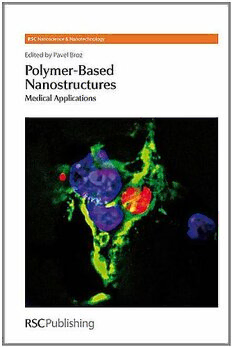
Polymer-based Nanostructures: Medical Applications (RSC Nanoscience & Nanotechnology) PDF
389 Pages·2010·4.54 MB·English
Most books are stored in the elastic cloud where traffic is expensive. For this reason, we have a limit on daily download.
Preview Polymer-based Nanostructures: Medical Applications (RSC Nanoscience & Nanotechnology)
Description:
Nanotechnology is about small things and medicine usually deals with bigger things - with patients and their diseases. The ultimate goal of all medical sciences is the healing of diseases whenever possible, otherwise the abatement of suffering. The first step of a successful medical treatment is the correct diagnosis of the disease or disease condition, based on clinical knowledge and experience and on diagnostic tools that give insight into macroscopic, microscopic, and biochemical properties of the disease process. Nanomaterials can improve currently available diagnostic applications in medicine and especially polymer-based nanostructures have an enormous potential to revolutionize the way how clinicians diagnose diseases correctly and efficiently. The second step when treating patients is a powerful and specific therapy that is low in side effects, that can prolong the survival of the patient or that can lower the burden of the disease. Again, polymer-based nanostructures are very promising novel tools that might change the way how certain diseases are being treated. This book combines both viewpoints and presents successful applications of nanotechnological constructs in medicine and the science behind the tools. Supramolecular nanometre-sized structures such as nanoparticles or vesicles built out of new synthetic polymeric materials have aroused enormous interest in recent years - both in chemical and pharmaceutical labs as well as in clinical medicine. They promise to be useful for novel or improved diagnostic and therapeutic applications for important diseases such as arteriosclerosis, cancer, infections, or autoimmune disorders. In the first part of this book, renowned researchers provide a detailed insight into both chemical and biological/pharmacological basics that have to be managed for successful applications of these nanostructures in human beings. In the second part, invited authors review the main literature in both diagnostic and therapeutic applications with polymer-based nanostructures that have already reached clinical practice or will enter it in the next few years. Key features include: -Multidisciplinary: The book is written by both clinicians from world-wide leading University Hospitals as well as researchers coming from natural sciences. Special effort was invested into comprehensibility across the traditional borders of medicine, pharmacology, and chemistry. -State-of-the-art: The book is filled with exciting contributions from some of the leading research groups in the field. This guarantees a clear emphasis on ongoing research and ground-breaking applications and projects -Structure: The book can be read from the beginning to the end, starting with basics that help to understand the current diagnostic and therapeutic applications of polymer-based nanostructures in medicine, ending with innovative multifunctional and "smart" nanostructures that might be the future of medicine. The way leads from solid foundations to nowadays applications and further to more futuristic approaches -References: The internationally renowned authors of the chapters have put great efforts into choosing only the most important and competitive papers for the reference lists. All major projects in this field are included - perfect for students or researchers that want to search the main literature thus avoiding the need to search through huge electronic databases
See more
The list of books you might like
Most books are stored in the elastic cloud where traffic is expensive. For this reason, we have a limit on daily download.
